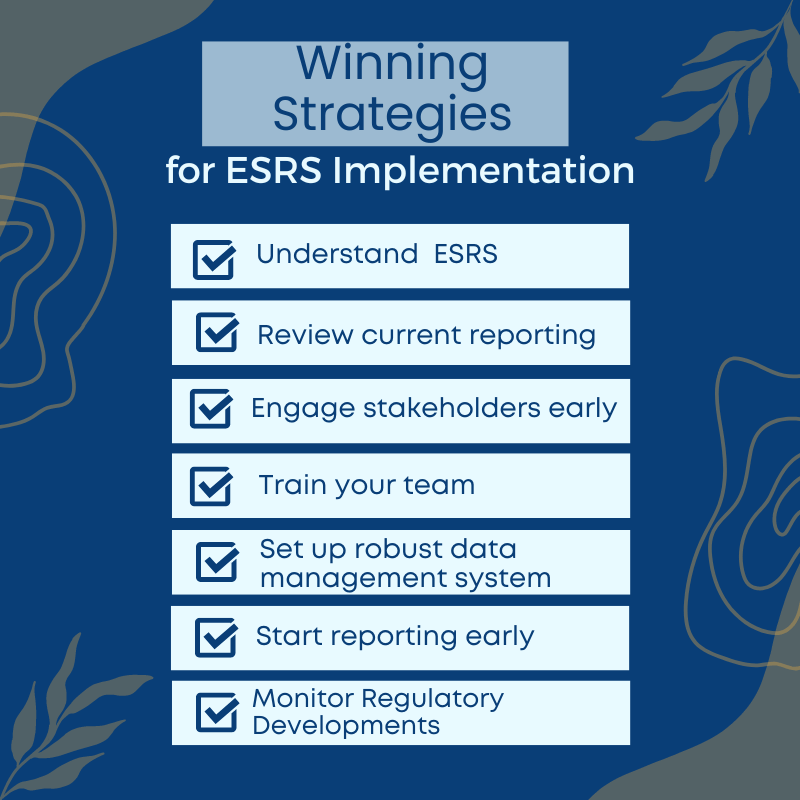Winning Strategies for ESRS Implementation
In an age where sustainability is not just a buzzword but a business imperative, how organizations report their sustainability performance is coming under increased scrutiny. The European Sustainability Reporting Standards (ESRS) are set to significantly enhance the consistency and transparency of sustainability reporting. Adopted by the European Commission in June 2023, the ESRS requires organizations to report on their sustainability performance. As businesses grapple with the implementation of these critical standards, the need for an effective strategy is paramount.
Understanding the European Sustainability Reporting Standards
Before diving into implementation strategies, it’s crucial to grasp what the ESRS entails. Developed by the European Financial Reporting Advisory Group (EFRAG), the ESRS consists of twelve standards designed to guide organizations in reporting their sustainability performance in a unified and transparent manner.
Taking a double materiality approach, the ESRS requires organizations to report both their economic and environmental impacts. The standards also align with global sustainability goals like the Task Force on Climate-related Financial Disclosures (TCFD) recommendations and the United Nations’ Sustainable Development Goals (SDGs).
Our ESRS Standards: Your Essential Overview blog offers a good overview of these 12 standards.
Building an Effective ESRS Implementation Strategy
Implementing the ESRS successfully requires meticulous planning and execution. Here are some winning strategies for a smooth ESRS transition:

1. Familiarize Yourself with the ESRS Standards
Understanding the ESRS standards is the first step in the process. Each standard pertains to a different aspect of sustainability reporting, from general disclosures to specifics like climate change, pollution, resource use, workforce, affected communities, consumers and end-users, and business conduct. Get to grips with each standard and its requirements to ensure your organization is prepared for comprehensive sustainability reporting.
2. Review Your Current Reporting Practices
A thorough review of your current sustainability reporting practices will help identify areas for improvement. This includes assessing your existing data collection methods, the sustainability metrics you track, and the level of detail in your reporting. Analyze gaps and weaknesses that the ESRS can address.
3. Engage Stakeholders Early
The implementation of ESRS will involve numerous stakeholders, both internal and external. Start dialogues early with these stakeholders, including management, employees, investors, regulators, and customers. Stakeholder input can provide valuable perspectives and support for ESRS implementation.
4. Train Your Teams
Invest in comprehensive ESRS training for your teams. Everyone involved in the reporting process needs to understand the requirements and their role in achieving compliance. This training should cover the specifics of each standard and how it applies to your organization.
The CSRD’s comprehensive courses is a good source of training for your team!
5. Set Up Robust Data Management Systems
The ESRS will require regular, reliable data on a variety of sustainability metrics. Your organization will need robust data management systems in place to collect, analyze, and report this data. Consider technology solutions that can automate and streamline this process.
6. Start Reporting Early
Don’t wait until the last minute to start reporting under the ESRS. Begin as early as possible, even if you start with just a few standards. Early reporting allows you to identify and resolve issues before they become major problems.
7. Monitor Regulatory Developments
Keep a close eye on regulatory developments related to the ESRS. As the standards are implemented across Europe, regulatory requirements and guidance may change. Staying up-to-date will ensure your reporting remains compliant.
Harnessing the Power of ESRS
Implementing the ESRS provides an opportunity for your organization to enhance its sustainability reporting, improve transparency, and demonstrate its commitment to sustainability. With the right strategy, you can turn the ESRS from a challenge into a powerful tool for business success.
Navigating ESRS implementation may seem daunting, but with preparation and strategic planning, your organization can not only comply but thrive under these new standards. Embrace the change and use it to drive your organization towards a more sustainable, resilient, and prosperous future.
Your Next Step on the CSRD Compliance Journey
Are you ready to spearhead your company’s sustainability journey and stand out from the crowd? The Corporate Sustainability Reporting Directive (CSRD) and European Sustainability Reporting Standards (ESRS) are not only coming but are here, and your next steps are critical.
Mastering the complexities of the CSRD and ESRS can seem like a daunting task. However, overcoming this challenge doesn’t just mean compliance with new laws – it’s an opportunity to show your commitment to a sustainable future, to gain a competitive edge, and to attract stakeholders who value responsibility.
We know it might be overwhelming, but you’re not alone in this journey. Imagine having all the necessary tools, knowledge, and support at your fingertips. That’s where The CSRD Compass steps in. We’re your ultimate guide to everything CSRD and ESRS, offering a rich collection of resources ranging from detailed guides and insightful articles to comprehensive courses and expert analysis. Navigating this new terrain of sustainability reporting has never been easier!
Don’t wait for tomorrow. The time to act is now. Embark on your sustainability reporting journey today, prepare your business for a sustainable future and make a real impact on our planet. Visit The CSRD Compass today, and let’s shape a greener future together!

